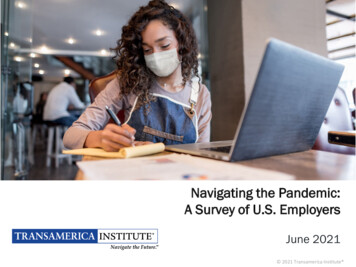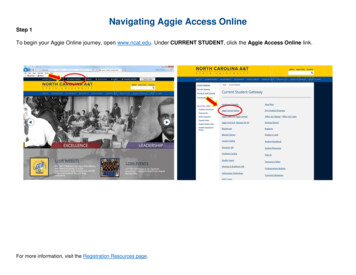
Transcription
Navigating the Pandemic:A Survey of U.S. EmployersJune 2021 2021 Transamerica Institute
Table of ContentsIntroductionsAbout the AuthorsAbout Transamerica Institute Methodology: Survey of EmployersTerminology and Sample SizesAcknowledgementsPage 3Page 4Page 5Page 6Page 7Navigating the Pandemic: A Survey of U.S. EmployersKey HighlightsRecommendationsDetailed Findings– The Pandemic’s Impact on Employers– Health and Welfare Benefits– Retirement BenefitsDemographics by Company SizePage 8Page 18Page 21Page 22Page 37Page 45Page 612
About the AuthorsCatherine Collinson serves as CEO and president of Transamerica Institute , a nonprofit private foundation which includesTransamerica Center for Retirement Studies . She is a champion for Americans who are at risk of not achieving a financiallysecure retirement. Catherine oversees all research, publications, and outreach initiatives, including the Annual TransamericaRetirement Survey.With more than two decades of retirement industry experience, Catherine has become a nationally recognized voice onretirement trends. She has testified before Congress on matters related to employer-sponsored retirement plans among smallbusiness, which featured the need to raise awareness of the Saver’s Credit among those who would benefit most from theimportant tax credit.In 2018, Catherine was named an Influencer in Aging by PBS’ Next Avenue. In 2016, she was honored with a Hero Award from theWomen’s Institute for a Secure Retirement (WISER) for her tireless efforts in helping improve retirement security among women.Catherine serves on the Advisory Board Leadership Council of the Milken Institute’s Center for the Future of Aging. She co-hoststhe ClearPath: Your Roadmap to Health & Wealth radio show on Baltimore’s WYPR, an NPR news station.Catherine is employed by Transamerica Corporation. Since joining the organization in 1995, she has held a number of positionswith responsibilities including the incorporation of Transamerica Center for Retirement Studies as a nonprofit private foundationin 2007 and its expansion into Transamerica Institute in 2013.Patti Rowey serves as vice president of Transamerica Institute. She is retirement and aging expert and helps manage and executeresearch initiatives, including the Annual Transamerica Retirement Survey. Patti has more than 20 years of retirement servicesexperience, specializing in market research covering a broad range of stakeholders, including retirement plan participants andsponsors, financial advisors, retirees – and future savers. She is employed by Transamerica Corporation.Heidi Cho is a senior research content analyst for Transamerica Institute. She began her career as an intern at TransamericaCenter for Retirement Studies in 2012. She joined the organization full time in 2014 upon graduating from the University ofSouthern California. She is employed by Transamerica Corporation.3
About Transamerica Institute Transamerica Institute (TI) is a nonprofit, private foundation dedicated to identifying, researching, andeducating the public about retirement security and the intersections of health and financial well-being. It isthe parent organization of Transamerica Center for Retirement Studies (TCRS) which conducts one of thelargest and longest-running annual retirement surveys of its kind. TI is funded by contributions from Transamerica Life Insurance Company and its affiliates and may receivefunds from unaffiliated third parties. Although care has been taken in preparing this material and presenting it accurately, TI disclaims anyexpress or implied warranty as to the accuracy of any material contained herein and any liability withrespect to it. The information provided here is for educational purposes only and should not be construed as insurance,securities, ERISA, tax, investment, legal, medical, or financial advice or guidance. Please consultindependent professionals for answers to your specific questions. www.transamericainstitute.org4
Methodology: Transamerica Institute and TCRS Survey of Employers The analysis contained in this report was prepared internally by the research team atTransamerica Institute (TI). A 25-minute, online survey was conducted from November 18 to December 20, 2020, amonga nationally representative sample of 1,903 employers by The Harris Poll on behalf of TI.Potential respondents were targeted based on job title at for-profit companies and met thefollowing criteria:– Business executives with specific titles who make decisions about employee benefits attheir company– Company employs at least one full-time employee across all locations Quotas were set by company size and results were statistically weighted as needed by usingtargets from the Dun & Bradstreet database to ensure the results are representative. In orderto ensure that this sample is fully representative of the targeted universe of employers, resultswere weighted by company size, annual revenue, industry and region. Percentages are rounded to the nearest whole percent.5
Terminology and Sample SizesThis report uses the following terminology:EmployersBase Size All employers: 1 or more employeesN 1,903 Small company: 1 to 99 employeesN 1,163 Medium company: 100 to 499 employeesN 230 Large company: 500 or more employeesN 5106
AcknowledgementsKelly AllsupElizabeth JacksonLaura ScullyKent CallahanDavid KraneFrank SottosantiSean CassidyEmily LauderSanjana TharuvesanchiHeidi ChoBryan MayaenAimee Vella RipleyCatherine CollinsonDavid OlmosMihaela VinczeAndrew CookKerry ParedesAshlee VogtPhil EckmanMaurice PerkinsPatti Vogt RoweySteve EichmannMarie PhillipsHolly WatersLard FrieseKaryn PolakAshley WeibelWill FullerJamie PostonSteven WeinbergMichelle GosneyJulie QuinlanHank WilliamsDavid HopewellDavid SchulzAllison Wilson7
Key HighlightsAs the worst public health crisis in more than acentury, the COVID-19 pandemic has upended theU.S. economy and everyday life. While muchattention has been given to the economic effects ofthe pandemic, relatively little has been statisticallyreported about how employers have navigatedthese challenging times.As a collaboration between nonprofit TransamericaInstitute and its Transamerica Center for RetirementStudies, Navigating the Pandemic: A Survey of U.S.Employers examines the pandemic’s impact onemployers, their response, and timely opportunities.This report is based on a survey of more than 1,900employers conducted during November andDecember 2020. It includes an analysis by companysize, including small (less than 100), medium (100to 499), and large for-profit companies (500-plusemployees).8
Key HighlightsThe Pandemic’s Impact on EmployersMost employers have been negatively impacted by the pandemic and more than half implemented difficult cost-cuttingmeasures that affected their employees, according to the survey’s findings. At the same time, many employers shared concernsabout COVID-19-related risks to their employees and felt responsible for their physical and mental health and well-being. Nine in10 employers implemented one or more types of support for their employees during the pandemic. Seven in 10 Employers Were Negatively Impacted by the Pandemic. Most employers (70 percent) have been severely orsomewhat negatively impacted by the coronavirus pandemic, including 23 percent that were severely impacted and 47percent that were somewhat impacted. One in five employers were not very impacted and only 10 percent were not at allimpacted. While many companies of all sizes have been negatively impacted by the pandemic, small companies (24percent) are slightly more likely to have been severely impacted, compared with medium (16 percent) and large companies(22 percent).Many Employers Have Implemented Cost-Cutting Measures. By late 2020, more than half of employers (54 percent) hadimplemented one or more cost-cutting measures since the pandemic began. The most often-cited measures included:layoffs or downsizing (19 percent) and elimination of bonuses (18 percent). Fourteen percent of employers implementedfurloughs, froze salaries, or reduced salaries or wages. Large (74 percent) and medium companies (70 percent) were morelikely to have implemented cost-cutting measures than small companies (49 percent).COVID-19 Issues Are a Major Concern for Company Leadership. Fifty percent of employers cite COVID-19-related issues asmajor concerns among their company’s leadership, with 43 percent of employers being concerned about the risk of anoutbreak within the company and 21 percent being concerned about the legal liabilities associated with COVID-19.Additionally, 47 percent of employers are concerned about employee health and safety, and 43 percent are concernedabout the economic environment. Only seven percent indicate their company’s leadership does not have any majorconcerns.Larger Employers Are More Likely to Be Concerned About COVID-19. Large (71 percent) and medium companies (74percent) are more likely to cite COVID-19-related issues as major concerns for their company’s leadership, compared withsmall companies (45 percent). Similarly, large (64 percent) and medium companies (59 percent) are more likely to beconcerned about their employees’ health and safety, compared with small companies (43 percent). Across company sizes,more than four in 10 employers cite the economic environment as a major concern for their company’s leadership.9
Key HighlightsThe Pandemic’s Impact on Employers (cont.) Most Employers Feel Responsible for Their Employees’ Well-Being. Most employers feel very or somewhat responsible forhelping their employees with various aspects of their health and well-being. Approximately eight in 10 employers feelresponsible for helping employees keep their skills up-to-date and relevant (82 percent), maintain mental health (81percent), and achieve work-life balance (80 percent). Seventy-four percent of employers feel responsible for helpingemployees maintain long-term health and well-being, while 65 percent feel responsible for helping them achieve afinancially secure retirement.More Than Four in Five Are Concerned About Employees’ Physical Health. Maintaining and safeguarding the physical healthof workers, especially amid the pandemic, is of the utmost importance. Eighty-two percent of employers are concernedabout employees maintaining their physical health, including 45 percent that are very concerned and 37 percent that aresomewhat concerned. Large (90 percent) and medium companies (84 percent) are slightly more likely to be concernedthan small companies (80 percent).More Than Three in Four Are Concerned About Employees’ Mental Health. Maintaining and safeguarding mental health isan important aspect of protecting the overall health and well-being of workers, especially during the pandemic. More thanthree in four employers (78 percent) are concerned about employees maintaining their mental health, including 44 percentthat are very concerned and 34 percent that are somewhat concerned. Large companies (90 percent) are more likely thansmall (77 percent) and medium companies (79 percent) to be concerned.Company Leaders Have Major Concerns About Mental Health. Seventy-three percent of employers cite one or more majorconcerns among their company’s leadership regarding the mental health of their employees. The most frequently selectedmajor concerns are anxiety (45 percent), extreme stress (42 percent), and depression (36 percent). Large (88 percent) andmedium companies (84 percent) are more likely than small companies (70 percent) to have one or more major concernsabout their employees’ mental health.How Mental Health Issues Are Negatively Impacting Employers. Fifty-nine percent of employers cite one or more ways thatemployees’ mental health issues are negatively impacting their company. Large (86 percent) and medium companies (82percent) are more likely than small employers (53 percent) to cite negative impacts. The most often-cited negative impactamong all employers is a loss of productivity (44 percent), followed by absenteeism (24 percent), dysfunctional workenvironment (20 percent), and turnover (19 percent).10
Key HighlightsThe Pandemic’s Impact on Employers (cont.) Two-Thirds of Employers Say Most Employees Work Remotely. Sixty-six percent of employers indicate most of theiremployees work remotely, including 45 percent working from home or anywhere and 21 percent equally leaving home to goto work or working remotely. Large (80 percent) and medium companies (73 percent) are somewhat more likely than smallcompanies (63 percent) to indicate that their employees work remotely. Small companies (38 percent) are more likely thanmedium (27 percent) and large companies (20 percent) to indicate most of their employees leave their home to go to work.Many Employers Offer Alternative Work-Related Arrangements. By offering workers the ability to make adjustments in theirschedules, employers can help ease the burden for their employees who are juggling work and other responsibilities, suchas caregiving and home-schooling. As of late 2020, 91 percent of employers offered some type of alternative workarrangement. The most frequently cited arrangements are flexible work schedules (66 percent), the ability to adjust workhours as needed (58 percent), and the ability to work remotely (53 percent). Large and medium companies are more likelythan small companies to offer alternative work arrangements.How Employers Are Supporting Employees During the Pandemic. Nine in 10 employers (90 percent) implemented one ormore types of support for their employees during the pandemic, including flexible work hours (59 percent), the ability towork remotely (53 percent), and safety measures for on-site workers (43 percent). Generally, large and medium companiesare more likely to provide various types of support to their employees than small companies.Almost Six in 10 Employers Plan to Facilitate Vaccination. In late 2020, 59 percent of employers planned to implement oneor more COVID-19 vaccination-related business practices and policies when a vaccine became available. Large (89percent) and medium companies (77 percent) were more likely than small companies (52 percent) to be planning to do so.Across company sizes, 36 percent (net) of employers planned to implement a vaccination requirement, 29 percent plannedto provide education about vaccinations, and 25 percent planned to provide paid time off to get vaccinated. Twenty-onepercent hadn’t developed a plan and 20 percent planned to not implement any vaccination-related practices or policies.Given the magnitude of the challenges faced and difficult decisions they were making, it is remarkable how employers rose tothe occasion and found ways to support their employees.11
Key HighlightsHealth and Welfare BenefitsA robust employee benefits package is a win-win situation in the workplace. It can help employers attract and retain talent whileproviding employees with the ability to save for retirement and protect their health, well-being, and financial situation. Thesevaluable benefits can be especially helpful to employees during a pandemic.Health, disability, life, and other types of insurance protections can mitigate the risks of financial shocks. Workplace wellnessprograms can potentially help employers lower their health insurance costs by promoting good health among employees. Manyworkers have been or may be called upon to be a caregiver for an aging parent or loved one. The survey finds that employerscan do even more to support their caregiving employees in ways that help them manage work-life balance and maintainproductivity. The Importance of Compensation, Benefits, and Flexibility. Employers recognize the importance of compensation andbenefits to attract and retain employees. Sixty-three percent cite salary/pay as being very important, while 60 percent (net)cite employee benefits including health insurance (47 percent), retirement benefits (36 percent), and/or other benefits (25percent). Medium and large companies (both 86 percent) are significantly more likely than small companies (54 percent)to cite employee benefits as being very important, while small companies (61 percent) are more likely than medium (50percent) and large companies (52 percent) to cite flexible work schedules as very important.Employers Offer a Variety of Health and Welfare Benefits. Most employers (70 percent) offer one or more types of healthand welfare benefits to their employees. Health insurance (57 percent) is the most frequently offered benefit, followed bylife insurance (33 percent), an employee assistance program (29 percent), and disability insurance (27 percent). Almostone in four employers (24 percent) offer a workplace wellness program. Large and medium companies are significantlymore likely than small companies to offer these types of benefits. For example, 82 percent of large companies and 84percent of medium companies offer health insurance, compared with just 51 percent of small companies.Types of Health Plans Included in Health Insurance Coverage. Among employers that offer health insurance to theiremployees, 52 percent offer a health savings account (HSA) and/or flexible spending account (FSA). Large (69 percent)and medium companies (62 percent) are significantly more likely to offer these than small companies (46 percent). Almosthalf of all employers offer preferred provider organizations (PPOs) and health maintenance organizations (HMOs) (both 49percent).12
Key HighlightsHealth and Welfare Benefits (cont.) Reasons for Not Offering Health Insurance. Among employers not offering health insurance to their employees, the mostfrequently cited reasons for not doing so are the company is not big enough (67 percent) and concern about cost (36percent).Workplace Wellness Programs Include a Variety of Features. Among the 24 percent of employers that offer a workplacewellness program, the most frequently cited components of the program include mental health support (58 percent),fitness programs (50 percent), and health screenings/biometric assessments/vaccinations (48 percent). Offerings withinan employer’s workplace wellness program generally increase with company size.Workplace Wellness Programs Enjoy Strong Participation. More than half of all employers (54 percent) indicate the averagelevel of participation in their workplace wellness programs is high (32 percent) or very high (22 percent). Large companiesare somewhat more likely than medium and small companies to report high levels of participation.Employers Can Do More to Support Caregiving Employees. From time to time, many employees find themselves needing tobe a caregiver for an aging parent or loved one. Six in 10 employers (60 percent) offer one or more programs to supportcaregiving employees. Large (95 percent) and medium companies (87 percent) are much more likely than smallcompanies (52 percent) to do so. However, much more can be done by employers of all sizes. Only about one in fiveemployers offer online resources and/or tools to support caregivers (23 percent), an employee assistance program (22percent), training for managers (20 percent), and/or a benefit that offers referrals to backup care (18 percent).Large and medium companies offer more robust health and welfare benefit offerings than small companies, a survey findingthat is consistent with pre-pandemic trends. However, there is room for growth among companies of all sizes. As employersbegin to emerge from the pandemic and envision their post-pandemic workplaces, they have an opportunity to learn more abouthow they can enhance their benefits offerings. The employee benefits marketplace is highly competitive, and employers mayfind that these types of win-win solutions are more affordable than they think.13
Key HighlightsRetirement BenefitsEmployer-sponsored retirement plans, including 401(k)s and similar employee-funded plans, are also essential for employers toattract and retain talent. These benefits have proven to be one of the most effective ways to facilitate long-term savings amongworkers. Similar to other employee benefits, larger companies tend to provide more robust offerings than small companies. Amongthose offering retirement benefits, many are focused on their full-time workforce and do not extend benefits to part-time employees. Importance of Retirement Plans Attracting and Retaining Talent. Seventy-four percent of employers believe that offering anemployee-funded retirement plan package is important for attracting and retaining employees. Large (55 percent) andmedium companies (59 percent) are more likely than small companies (30 percent) to believe that it is important.Retirement Benefits Offered to Employees. Fifty-two percent of employers offer a 401(k) or similar employee-fundedretirement plan to their employees. Employee-funded plans are more commonly offered by large (90 percent) and mediumcompanies (83 percent), compared with small companies (44 percent). Company-funded defined benefit plans are onlyoffered by 17 percent of employers. About four in 10 employers (41 percent) do not offer any retirement benefits to theiremployees. Small companies (50 percent) are significantly more likely to indicate they do not offer any retirement benefits,compared with medium (4 percent) and large companies (1 percent).Non-Sponsors Not Planning to Offer a Plan. Among companies that do not offer a 401(k) or similar employee-funded plan, only37 percent say they are likely to begin sponsoring a plan in the next two years. The most frequently cited reasons amongcompanies not planning to do so include they are not big enough (74 percent), they are concerned about cost (35 percent),and their employees are not interested (11 percent). However, there may be cause for optimism regarding the future, as 30percent of those not likely to offer a plan say they would consider joining a multiple employer plan (MEP) or a pooled employerplan (PEP) that handles many of the fiduciary and administrative duties at a reasonable cost.Extending Eligibility to Part-Time Employees. Among employers that offer a 401(k) or similar retirement plan to theiremployees, only 51 percent extend eligibility to part-time workers. Large (64 percent) and medium companies (51 percent) aresomewhat more likely to extend eligibility to part-time workers than small companies (46 percent). Among plan sponsors thatdo not extend eligibility to part-time workers, 39 percent do not plan to do so in the future. Their most frequently cited reasonsinclude generally impractical (43 percent), high turnover rates among part-time employees (39 percent), and concerned aboutcost (37 percent). The SECURE Act of 2019 requires plan sponsors to extend eligibility to long-term (three years of service),part-time workers. Employers are required to track years of service beginning in 2021, thus long-term, part-time workers willfirst be eligible in 2024.14
Key HighlightsRetirement Benefits (cont.) More Than Nine in 10 Plans Include an Employer Contribution. Ninety-two percent of plan sponsors make an employercontribution as part of their 401(k) or similar plan, including 98 percent of both large and medium companies, and 89percent of small companies. Large (87 percent) and medium companies (85 percent) are more likely than smallcompanies (66 percent) to make a contribution in the form of a company match. An employer’s matching contributioncan be one of the most important features of a 401(k) or similar plan, as both an incentive for employees to join theplan and a means of enabling them to build their retirement savings.Roth 401(k) Offering. Sixty-four percent of plan sponsors offer a Roth 401(k) option. Large (77 percent) and mediumcompanies (70 percent) are more likely to offer this feature than small companies (58 percent).Adoption of Automatic Features Increases With Company Size. Twenty-five percent of plan sponsors have adoptedautomatic enrollment, including 23 percent of small and 27 percent of both medium and large companies. Among them,the default contribution rate is 10 percent (median) of an employee’s pay. Sixty-eight percent of plan sponsors haveadopted automatic escalation, a feature that automatically increases participants’ contribution rates annually.Automatic escalation is more common at large (80 percent) and medium companies (75 percent) than at smallcompanies (63 percent).Professionally managed services such as managed accounts and asset allocation suites, including target date andtarget risk funds, have become ubiquitous options in 401(k) or similar plans, with 87 percent of plan sponsors offeringthem. Such offerings enable plan participants to invest in professionally managed services or funds that are essentiallytailored to their goals, years to retirement, and/or risk tolerance profile. They can help participants with asset allocationwithout their having to become investment experts themselves. As with many other plan features, large companies aremore likely to offer these than small companies.Offerings to Help Employees Plan, Save, and Invest for Retirement. Among employers that offer a 401(k) or similar plan,plan sponsors offer a variety of online tools and resources, professional advice, informative emails,seminars/meetings/webinars/ workshops, and mobile apps, in addition to quarterly statements. Generally, smallcompanies are less likely to offer their employees assistance with planning, saving, and investing for retirement,compared with medium and large companies.15
Key HighlightsRetirement Benefits (cont.) IRS Saver’s Credit Awareness. The Saver’s Credit is a tax credit available to eligible taxpayers who are saving for retirementin a qualified retirement plan or IRA. Only 37 percent of all employers are both aware of the Saver’s Credit and activelypromoting it to their employees, but this awareness increases with company size. Large (74 percent) and mediumcompanies (67 percent) are significantly more likely to be aware of the tax credit and actively promoting it, compared withsmall companies (29 percent).Some Employers Offer Information About Government Benefits. As part of their retirement planning-related educationalofferings, slightly more than half of employers provide information about Social Security (54 percent) and Medicare (52percent) benefits. Small companies are much less likely to provide such information about government benefits thanmedium and large companies.Assistance Transitioning Savings & Finances Into Retirement. Workers nearing retirement face a myriad of complexdecisions regarding transitioning their savings and finances into retirement, and plan sponsors have an importantopportunity to work with their retirement plan providers to assist them. However, few provide things such as: educationalresources (39 percent), information about distribution options (38 percent), retirement planning materials (37 percent),referrals to the company’s retirement plan provider (36 percent), and education about transitioning into retirement (35percent).Offering of Retirement Transition Assistance. Most employers (74 percent) offer one or more forms of retirement transitionassistance. Large and medium companies (95 percent, 92 percent respectively) are more likely than small companies (69percent) to do so. However, relatively few offer robust offerings. Only 41 percent of employers offer flexible work schedulesto help employees transition into retirement. Even fewer enable employees to shift from full-time to part-time (36 percent),take on jobs that are less stressful or demanding (28 percent), or participate in succession planning, training, andmentoring (28 percent). Moreover, employers are missing an opportunity to facilitate smoother transitions when theiremployees do retire, with only 21 percent offering retirement-oriented lifestyle and transition planning resources and 20percent providing information about encore career opportunities.Offer a Formal Phased Retirement Program. Sixty-nine percent of employers do not offer a formal phased retirementprogram, including 33 percent that plan to implement a program in the future and 36 percent that do not have plans to doso. However, the offering of a formal phased retirement program increases with company size. Large (66 percent) andmedium companies (49 percent) are significantly more likely to offer such programs than small companies (19 percent).16
Key HighlightsRetirement Benefits (cont.) Reasons for Not Offering a Formal Phased Retirement Program. The most frequently cited reasons for not offering aphased program are that employees are not interested (39 percent), it is easier to address employees’ requests on acase-by-case basis (34 percent), and operational and administrative complexity (23 percent). Large companies (45percent) are significantly more likely to cite concerns about age- and employment-related discrimination laws as areason for not offering phased retirement, compared with medium (28 percent) and small companies (10 percent).Larger companies are more likely to offer robust retirement benefit offerings compared with smaller companies. However,there is ample room for growth among companies of all sizes. With the enactment of the SECURE Act in late 2019, there arenow more options available in the marketplace and tax incentives for employers to start a plan. Employers that do offer aplan should consider consulting with their plan providers to ensure their employees are taking full advantage of the planfeatures, investments, and related services, planning tools, and educational resources available. As much as employers aredoing to help employees save and invest, the survey finds they can do more to support employees who are transitioning intoretirement.A Call to ActionEmployers play a vital societal role by providing employment, work experience, employee benefits, and the ability for w
employees maintain long-term health and well-being, while 65 percent feel responsible for helping them achieve a financially secure retirement. More Than Four in Five Are Concerned About Employees' Physical Health. Maintaining and safeguarding the physical health of workers, especially amid the pandemic, is of the utmost importance.










